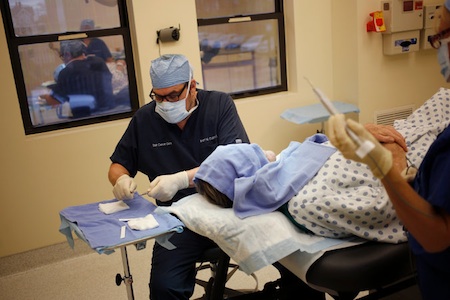Kim Little had not thought much about the tiny white spot on the side of her cheek until a physician’s assistant at her dermatologist’s office warned that it might be cancerous. He took a biopsy, returning 15 minutes later to confirm the diagnosis and schedule her for an outpatient procedure at the Arkansas Skin Cancer Center in Little Rock, 30 miles away.
That was the prelude to a daylong medical odyssey several weeks later, through different private offices on the manicured campus at the Baptist Health Medical Center that involved a dermatologist, an anesthesiologist and an ophthalmologist who practices plastic surgery. It generated bills of more than $25,000.
“I felt like I was a hostage,” said Ms. Little, a professor of history at the University of Central Arkansas, who had been told beforehand that she would need just a couple of stitches. “I didn’t have any clue how much they were going to bill. I had no idea it would be so much.”
Ms. Little’s seemingly minor medical problem — she had the least dangerous form of skin cancer — racked up big bills because it involved three doctors from specialties that are among the highest compensated in medicine, and it was done on the grounds of a hospital. Many specialists have become particularly adept at the business of medicine by becoming more entrepreneurial, protecting their turf through aggressive lobbying by their medical societies, and most of all, increasing revenues by offering new procedures — or doing more of lucrative ones.
It does not matter if the procedure is big or small, learned in a decade of training or a weeklong course. In fact, minor procedures typically offer the best return on investment: A cardiac surgeon can perform only a couple of bypass operations a day, but other specialists can perform a dozen procedures in that time span.
That math explains why the incomes of dermatologists, gastroenterologists and oncologists rose 50 percent or more between 1995 and 2012, even when adjusted for inflation, while those for primary care physicians rose only 10 percent and lag far behind, since insurers pay far less for traditional doctoring tasks like listening for a heart murmur or prescribing the right antibiotic.
By 2012, dermatologists — whose incomes were more or less on par with internists in 1985 — had become the fourth-highest earners in American medicine in some surveys, bringing in an average of $471,555, according to the Medical Group Management Association, which tracks doctors’ income, though their workload is one of the lightest.
In addition, salary figures often understate physician earning power since they often do not include revenue from business activities: fees for blood or pathology tests at a lab that the doctor owns or “facility” charges at an ambulatory surgery center where the physician is an investor, for example.
“The high earning in many fields relates mostly to how well they’ve managed to monetize treatment — if you freeze off 18 lesions and bill separately for surgery for each, it can be very lucrative,” said Dr. Steven Schroeder, a professor at the University of California and the chairman of the National Commission on Physician Payment Reform, an initiative funded in part by the Robert Wood Johnson Foundation.
Doctors’ charges — and the incentives they reflect — are a major factor in the nation’s $2.7 trillion medical bill. Payments to doctors in the United States, who make far more than their counterparts in other developed countries, account for 20 percent of American health care expenses, second only to hospital costs.
Specialists earn an average of two and often four times as much as primary care physicians in the United States, a differential that far surpasses that in all other developed countries, according to Miriam Laugesen, a professor at Columbia University’s Mailman School of Public Health. That earnings gap has deleterious effects: Only an estimated 25 percent of new physicians end up in primary care, at the very time that health policy experts say front-line doctors are badly needed, according to Dr. Christine Sinsky, an Iowa internist who studies physician satisfaction. In fact, many pediatricians and general doctors in private practice say they are struggling to survive.
Studies show that more specialists mean more tests and more expensive care. “It may be better to wait and see, but waiting doesn’t make you money,” said Jean Mitchell, a professor of health economics at Georgetown University. “It’s ‘Let me do a little snip of tissue’ and then they get professional, lab and facility fees. Each patient is like an ATM machine.”
For the full article, go to http://www.nytimes.com/2014/01/19/health/patients-costs-skyrocket-specialists-incomes-soar.html?exprod=myyahoo&_r=0.
